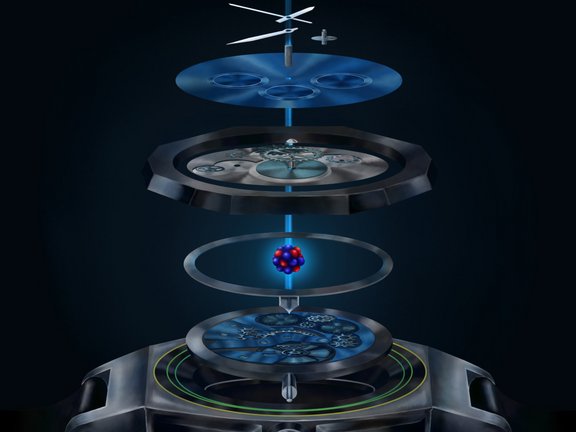Modern atomic clocks are among the most accurate measurement tools. The best instruments now in operation lose one second in 30 billion years. However, even this extraordinary level of precision can be improved upon. Indeed, a clock based on a transition in the nucleus of the isotope thorium-229 should make it possible to enhance timing accuracy by another order of magnitude. Now a research team succeeded in measuring the energy of this transition. The team led by Peter Thirolf from LMU Munich, in collaboration with colleagues at the Max Planck Institute for Nuclear Physics in Heidelberg, the GSI Helmholtz Centre for Heavy-Ion Research in Darmstadt, Mainz University, the University of Bonn and the Technical University of Vienna, has thus taken an essential step toward the realization of a thorium-based nuclear clock, as reported in Nature.
Unlike current atomic clocks, which make use of oscillations in the electron shells of atoms, nuclear clocks employ oscillations within the nucleus as their timekeeper. In both cases, the oscillations are the product of transitions between defined energy levels, which can be excited by laser light of a specific wavelength. Unfortunately, the energies required to excite oscillations in the vast majority of atomic nuclei are orders of magnitude higher than those required to stimulate transitions in the orbital shells of electrons. But the thorium-229 atom is an exception: It exhibits an excited state whose excitation energy is the lowest found in any of the approximately 3800 atomic nuclei known to date. Irradiation with ultraviolet light, which is within the capability of lasers now available, is sufficient to populate this excited state. However, up to now, the properties of the thorium-229 nucleus are not known with sufficient accuracy. This is particularly important as to induce the nuclear transition, the wavelength of the laser light must be tuned to match the transition energy exactly.
Measurement required tricks
Reaching the excited state in thorium directly is very difficult. This is why the experiment employed radioactive sources produced in Mainz which contained nuclei in the excited state. For the measurement, the doubly charged cations were isolated with the aid of a dedicated ion trap developed at LMU. Crucially, the excited state of the cation has a lifetime of several thousand seconds, which is relatively long for an excited nuclear state. The long lifetime of this state means that decay to the ground state – which is what one wants to measure – is seldom observed. However, if one restores the missing electrons, decay occurs very rapidly.
To add the electrons back, the scientists used a trick: they fired the ions through a layer of graphene. On its way through, each ion picks up two electrons and emerges as a neutral atom on the other side. Thanks to this controlled neutralization step, the excited state then decays to the ground state within a few microseconds, and the energy released is sufficient to expel an electron from an outer shell of the atom, generating a positively charged thorium ion. The kinetic energy of this free electron can in turn be determined using an electron spectrometer.
Simulations decipher the spectrum
The interpretation of the resulting spectra is no easy task, because the electron carries only a fraction of the energy used to generate the excited nuclear state and the rest remains in the thorium ion. It is only with the help of involved simulations that the energy associated with the decay of the excited nuclear state could be determined. The key role here was played by theorists from the Max Planck Institute for Nuclear Physics from Heidelberg led by Adriana Pálffy. “In the process of neutralization, energy is transferred to the electronic shell. As a consequence, most of the thorium atoms are not in the electronic ground state, but in excited states. This significantly complicates our data analysis”, says Pavlo Bilous, the doctoral student involved, which has meanwhile successfully obtained his degree.
The result indicates that the thorium-229 nucleus can be raised to its first excited state by irradiation with laser light at a wavelength of around 150 nanometers. Now lasers specifically designed to emit in this vacuum ultraviolet range can be constructed. This step will bring the first nuclear clock a great deal closer to practical realization. The researchers believe that a thorium-based nuclear clock will find multiple applications in fundamental research, since many of the open questions in atomic physics can only be answered on the basis of extremely precise measurements in the time domain.
Original publication:
Energy of the 229Th nuclear clock transition
Benedict Seiferle, Lars von der Wense, Pavlo V. Bilous, Ines Amersdorffer, Christoph Lemell, Florian Libisch, Simon Stellmer, Thorsten Schumm, Christoph E. Düllmann, Adriana Pálffy & Peter G. Thirolf
Nature 573, 243-246 (2019), DOI: 10.1038/s41586-019-1533-4
Group Pálffy in the division Keitel at the MPIK
